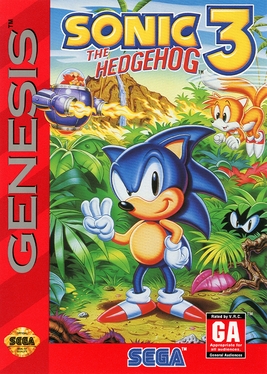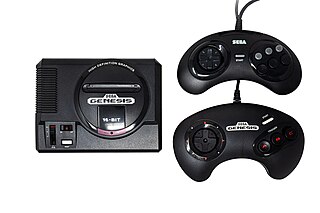Related Research Articles

The Atari 7800 ProSystem, or simply the Atari 7800, is a home video game console officially released by Atari Corporation in 1986 as the successor to both the Atari 2600 and Atari 5200. It can run almost all Atari 2600 cartridges, making it one of the first consoles with backward compatibility. It shipped with a different joystick than the 2600-standard CX40 and included Pole Position II as the pack-in game. The European model has a gamepad instead of a joystick. Most of the early releases for the system are ports of 1981–1983 arcade video games. The final wave of 7800 cartridges are closer in style to what was available on other late 1980s consoles, such as Scrapyard Dog and Midnight Mutants.

The Sega CD, known as Mega-CD in most regions outside North America and Brazil, is a CD-ROM accessory and format for the Sega Genesis produced by Sega as part of the fourth generation of video game consoles. Originally released in November 1991, it came to North America in late 1992, and the rest of the world in 1993. The Sega CD plays CD-based games and adds hardware functionality such as a faster CPU and a custom graphics chip for enhanced sprite scaling and rotation. It can also play audio CDs and CD+G discs.

Sonic the Hedgehog 3 is a 1994 platform game developed and published by Sega for the Sega Genesis. Like previous Sonic games, players traverse side-scrolling levels while collecting rings and defeating enemies. They control Sonic and Tails, who attempt to retrieve the Chaos Emeralds to stop Doctor Robotnik from relaunching his space station, the Death Egg, after it crash-lands on a mysterious floating island. Sonic 3 introduces Knuckles the Echidna, the island guardian, who lays traps for Sonic and Tails.

The Master System is an 8-bit third-generation home video game console manufactured and developed by Sega. It was originally a remodeled export version of the Sega Mark III, the third iteration of the SG-1000 series of consoles, which was released in Japan in 1985 with improved graphical capabilities compared to its predecessors. The Master System launched in North America in 1986, followed by Europe in 1987, and then in Brazil and Korea in 1989. A Japanese version of the Master System was also launched in 1987, which features a few enhancements over the export models : a built-in FM audio chip, a rapid-fire switch, and a dedicated port for the 3D glasses. The Master System II, a cheaper model, was released in 1990 in North America, Australasia and Europe.

Sonic the Hedgehog is a 1991 platform game developed by Sonic Team and published by Sega for the Genesis/Mega Drive. It was released in North America on June 23 and in PAL regions and Japan the following month. Players control Sonic the Hedgehog, who can run at near supersonic speeds; Sonic sets out on a quest to defeat Dr. Robotnik, a scientist who has imprisoned animals in robots and seeks the powerful Chaos Emeralds. The gameplay involves collecting rings as a form of health, and a simple control scheme, with jumping and attacking controlled by a single button.

Sonic the Hedgehog is a 1991 platform video game developed by Ancient and published by Sega for the Master System and Game Gear. It is a companion to the 16-bit Sega Genesis game Sonic the Hedgehog for the 8-bit Sega Master System and Game Gear consoles. Ancient—a studio founded by composer Yuzo Koshiro—was contracted to develop the game. The 8-bit Sonic is a side-scrolling game similar in style to the 16-bit game, but reduced in complexity to fit the 8-bit systems.

ChuChu Rocket! is a 1999 action puzzle game developed by Sonic Team and published by Sega for the Dreamcast. The objective is for the player to place arrows on a board to lead mice into escape rockets while avoiding cats. The game features single-player modes in which a player must save all the mice on a board, and a multiplayer mode in which players battle to collect the most mice.

Sonic & Knuckles is a 1994 platform game developed and published by Sega. Players control Sonic the Hedgehog or Knuckles the Echidna in their quests to save Angel Island; Sonic tries to stop Doctor Robotnik from re-launching his orbital weapon, the Death Egg, while Knuckles scuffles with Robotnik's minion, EggRobo. Like previous Sonic games, players traverse side-scrolling levels at high speeds while collecting rings and defeating enemies.

Altered Beast is a 1988 beat 'em up arcade video game developed and published by Sega. The game is set in Ancient Greece and follows a player character chosen by Zeus to rescue his daughter Athena from the demonic ruler of the underworld, Neff. By collecting three power-ups in a level, the player character transforms into one of five magical beasts. It was ported to several home video game consoles and home computers. Altered Beast was the pack-in game when the Genesis launched in North America and the Mega Drive in Europe.
Fantasy Zone is a 1986 arcade video game by Sega, and the first game in the Fantasy Zone series. It was later ported to a wide variety of consoles, including the Master System. The player controls a sentient spaceship named Opa-Opa who fights an enemy invasion in the titular group of planets. The game contains a number of features atypical of the traditional scrolling shooter. The main character, Opa-Opa, is sometimes referred to as Sega's first mascot character.
Homebrew, when applied to video games, refers to software produced by hobbyists for proprietary video game consoles which are not intended to be user-programmable. The official documentation is often only available to licensed developers, and these systems may use storage formats that make distribution difficult, such as ROM cartridges or encrypted CD-ROMs. Many consoles have hardware restrictions to prevent unauthorized development.

Sega Ages is a series of video game ports, remakes, and compilations published by Sega. It consists of Sega arcade games and home console games, typically those for the Sega Genesis and Master System. The series was launched on the Sega Saturn in 1996. Entries were published for the PlayStation 2 as Sega Ages 2500, a reference to its bargain ¥2500 price point. The series later came to the Xbox 360 and PlayStation 3 as Sega Ages Online, and finally to the Nintendo Switch as simply Sega Ages. The name Sega Ages is a palindrome, with "Ages" being "Sega" backwards — this was previously used by Sega in European marketing strategies from the late 1980s to early 1990s.

The Sega Genesis, known as the Mega Drive outside North America, is a 16-bit fourth generation home video game console developed and sold by Sega. It was Sega's third console and the successor to the Master System. Sega released it in 1988 in Japan as the Mega Drive, and in 1989 in North America as the Genesis. In 1990, it was distributed as the Mega Drive by Virgin Mastertronic in Europe, Ozisoft in Australasia, and Tectoy in Brazil. In South Korea, it was distributed by Samsung Electronics as the Super Gam*Boy and later the Super Aladdin Boy.

Sonic the Hedgehog 2 is a 1992 platform game developed by Sega Technical Institute (STI) for the Sega Genesis. Players control Sonic as he attempts to stop Doctor Robotnik from stealing the Chaos Emeralds to power his space station. Like the first Sonic the Hedgehog (1991), players traverse side-scrolling levels at high speeds while collecting rings, defeating enemies, and fighting bosses. Sonic 2 introduces Sonic's sidekick Miles "Tails" Prower and features faster gameplay, larger levels, a multiplayer mode, and special stages featuring pre-rendered 3D graphics.
Puyo Puyo (ぷよぷよ), previously known as Puyo Pop outside Japan, is a series of tile-matching video games created by Compile. Sega has owned the franchise since 1998, with games after 2001 being developed by Sonic Team. Puyo Puyo was created as a spin-off franchise to Madō Monogatari, a series of first-person dungeon crawler role-playing games by Compile from which the Puyo Puyo characters originated. The series has sold over 10 million copies, including the Madō Monogatari games.
The Sega Card, known in Japan as Sega My Card, is a memory card format used as game storage for the SG-1000/SC-3000 and the Mark III / Master System. Produced from 1985 to 1987 by Mitsubishi Plastics, the cards are plugged into onboard cardslots or into compatible adapters. Several versions of the format were created, including a rewritable one that allows new titles to be downloaded to a card. While substantially cheaper to produce than cartridges, the storage limitations of the format resulted in Sega exclusively distributing games on cartridges. Despite the failure of the Sega Card, NEC found more success with its own memory card format, the HuCard, which was the primary storage medium for its PC Engine game console.

Sega Forever was a service from the Japanese video game developer Sega for re-releasing past games from the company on modern platforms. The service was launched for Android and iOS devices on June 22, 2017. By 2020, the service included over 30 games. In September of 2023 Sega quietly discontinued services by de-listing applications and leaving their social media pages inactive.

The Sega Genesis Mini, known as the Mega Drive Mini in regions outside of North America, is a dedicated console modeled on the Sega Genesis. The Mini emulates the original console's 16-bit hardware, and includes 42 games made available through emulation software by M2. It was released in North America and Japan in September 2019 and in Europe and the Middle East in October 2019. A follow-up, Sega Genesis Mini 2, was released in October 2022 and includes 60 games from the Genesis and Sega CD.
In the video game industry, a console war describes the competition between two or more video game console manufacturers in trying to achieve better consumer sales through more advanced console technology, an improved selection of video games, and general marketing around their consoles. While console manufacturers are generally always trying to out-perform other manufacturers in sales, these console wars engage in more direct tactics to compare their offerings directly against their competitors or to disparage the competition in contrast to their own, and thus the marketing efforts have tended to escalate in back-and-forth pushes.

Alex Kidd is a platform video game series developed by Sega.
References
- ↑ The Games Machines, ISBN 978-3-000-15359-4 p. 198
- ↑ "Sega Does: Snail Maze". segadoes.com. November 1, 2014. Retrieved September 15, 2021.
- ↑ Sega Master System Snail Maze full playthrough , retrieved 2021-09-21
- ↑ Service Games: The Rise and Fall of SEGA: Enhanced Edition, ISBN 978-1-494-28835-8 p. 36
- ↑ "Snail Maze for iOS (IPhone/IPad) - GameFAQs".
- ↑ "Snail Maze v1.0.0". www.cemetech.net. 20 December 2015. Retrieved 2021-09-07.
- ↑ "C64 Snail Maze +".